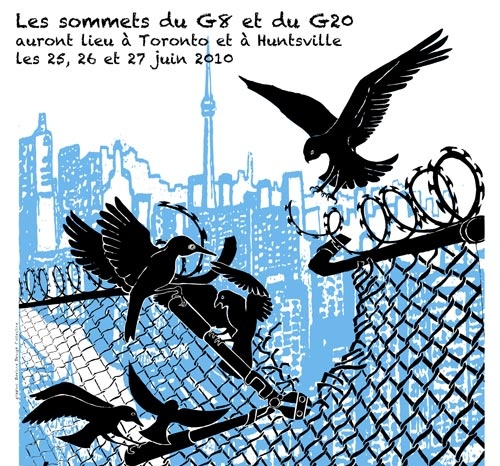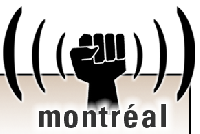 |
 |
 |
 |
 |
 |
|
 |
 |
 |
 |
 |
 |
 |
Régions du Québec |  |
 |
 |
|
 |
 |
|
 |
 |
|
 |
 |
 |
 |
 |
 |
Rubriques (sujets) |  |
 |
 |
|
 |
 |
|
 |
|
 |
 |
 |
Sectarian violence in Iraq: who’s responsible?
27 February 2005. A World to Win News Service. The US bears a large share of the responsibility for the violence between Shia and Sunni Moslems that has killed so many people in Iraq over the last week, and actually many months.
It has been reported that the blast that destroyed the golden-domed Askariya Shia mosque in Samarra on February 22 was carried out by men wearing Interior Ministry uniforms. The dozen or so gunmen, who took over the mosque for about an hour before blowing it up as other men outside cordoned off the building and kept neighbourhood people away, were said to have little fear of being interrupted.
It is widely recognized that Iraq’s Interior Ministry is run by the Supreme Council for Islamic Revolution in Iraq, a pro-US Shia party that is central to the alliance of forces the US has put together to form an Iraqi government. Ministry of the Interior death squads have been hunting down and murdering Sunni leaders and their families. Last year the Ministry of the Interior headquarters itself was revealed to be the site of an unofficial torture and death centre. This was confirmed most recently by outgoing UN human rights chief John Pace, who spoke of up to 900 bodies a month turning up at the Baghdad morgue with bullet holes in the head or drill holes and burn marks. "Much of the killing, he said, was carried out by Shia Muslim groups under the Ministry of the Interior" (UK Independent, 26 February).
US troops have often handed over prisoners to be taken there, and various US authorities have visited the site. This has been repeatedly documented in the foreign press since the middle of last year. The Bush regime’s claims in the last week that they knew nothing about this are not credible.
It is possible that the Golden Mosque was blown up by Sunni fundamentalist fanatics further enflamed by a climate of anti-Sunni ethnic cleansing. They seem to have done far worse – for instance, last year’s slaughter of Shia day labourers queuing up for work. It is also possible that Ministry of Interior commandos or other men linked to American-allied Shia government forces destroyed the shrine in order to provoke a Shia backlash against Sunnis. Such a backlash is in fact what happened – some 100 Sunni mosques were attacked, apparently not by unorganised Shia crowds but by organized Shia militias.
It should be remembered that last year two undercover British SAS soldiers dressed in local clothing were caught in predominantly Shia Basra with a car full of bombs and detonators. British armoured vehicles and troops broke these two men out of the jail where local authorities were holding them before they could be tried and the truth brought to light. Also, the bombing of the Shia shrine could not have come at a better time for the occupiers. A wave of anti-occupation rage swept Iraq and much of the world after an Australian TV station broadcast new photos from Abu Ghraib that the Bush regime had previously suppressed, showing not only abuse but corpses. The release of a video taken by British soldiers showing them severely beating arrested teenage demonstrators in Basra had forced local Shia authorities to take anti-British measures. (Pointed out by Dahr Jamail at dahrjamailiraq.com)
We don’t know who bombed the shrine, but we do know who benefited: the occupiers. We also know this: No matter who blew up the Golden Mosque, it is certain that the US helped set the stage for today’s sectarian violence, even if the consequences may be out of their control.
First of all, American policy has been to ally with and put into power the most backward forces in Iraqi society: Shia, Sunni and Kurdish religious, feudal, tribal and clan leaders, chief among them Ali Sistani, the Shia Grand Ayatollah who went along with Saddam Hussein just as he does now with the Americans.
Secondly, the US has fomented the most blatant "identity politics" in which these men contend for the political and economic spoils of the occupation in the name of the ethnic group they try to run, against the interests of the people as a whole and to the benefit of the invaders and their classical divide and rule approach.
Further, the US deliberately took a hands-off attitude during the recent bloodletting, just as it did during the long months that this has been brewing. Today they contend that defending civilians is not their mission. Contrast this with what they’ve done when their occupation is challenged or attacked in places like Falluja, where they rained down death on the whole civilian population. Not authorized to protect civilians but authorized to kill them – this is an accurate description of the American armed forces.
The Pentagon announced that amid the anti-Sunni pogroms, their goal was to "remain in a role of advising and supporting Iraqi security forces", as The New York Times described it on February 25. Since the so-called "Iraqi security forces", the police and army alike, are run by Shia militias who have been carrying out ethnic slaughter, this policy speaks for itself. During the last week US commanders pulled back and watched Iraqis kill Iraqis like spectators enjoying a prize fight.
This is what Bush’s "Iraqization" of the occupation is about: finding local stooges who will help repress the Iraqi people, men who seize their own rewards in the course of this and fight among one another so that they can never threaten the real power in the country, the occupying armies.
This goes back to the Ottoman empire and the British who ruled Iraq by favouring a Sunni elite against the Shia majority and the Kurds. US policy has been to do the same in reverse, favouring backward forces among the Shia and Kurds against an insurgency that they consider largely based among Sunnis – once again to the detriment of the broad masses of the country’s peoples.
However, it should be remembered that when the predominantly Sunni city of Falluja stood up to the invaders, the resistance was supported by people all over Iraq. People in Shia neighbourhoods in Baghdad risked their lives to drive truckloads of supplies to the encircled city and welcomed refugees after the US flattened it. Even an Iraqi puppet army brigade sent to help the Americans mutinied. Arab-speaking reporters and Iraqi bloggers have noted many incidents of anti-occupier sentiment uniting Iraqis of different ethnicities during the last week.
The US did not create all that the Iraqi people need to get rid of through a thoroughgoing revolution. Backward economic and social relations are what have made Iraqi society vulnerable to imperialist domination. But nothing good can happen in Iraq until the US is kicked out – and it is that struggle and that struggle alone that could unite the Iraqi people.
- end item-
 |
 |
 |
 |
Dossier G20 |  |
 |
 |
|
 |
 |
|
 |
Nous vous offrons plusieurs reportages indépendants et témoignages...

Liste des activités lors de ce « contre-sommet » à Toronto Vous pouvez aussi visiter ces médias alternatifs anglophones... Centre des médias Alternatifs Toronto 2010.mediacoop.net Media Co-op Toronto http://toronto.mediacoop.ca Toronto Community Mobilization www.attacktheroots.net (en Anglais) |
 |
 |
 |
 |
 |
 |
 |
CMAQ: Vie associative |  |
 |
 |
|
 |
 |
|
 |
 Collectif à Québec: n'existe plus. Impliquez-vous ! |
 |
 |
 |
 |
 |
 |
 |
 |
|
 |
 |
 |
Ceci est un média alternatif de publication ouverte. Le collectif CMAQ, qui gère la validation des contributions sur le Indymedia-Québec, n'endosse aucunement les propos et ne juge pas de la véracité des informations. Ce sont les commentaires des Internautes, comme vous, qui servent à évaluer la qualité de l'information. Nous avons néanmoins une
Politique éditoriale
, qui essentiellement demande que les contributions portent sur une question d'émancipation et ne proviennent pas de médias commerciaux.
This is an alternative media using open publishing. The CMAQ collective, who validates the posts submitted on the Indymedia-Quebec, does not endorse in any way the opinions and statements and does not judge if the information is correct or true. The quality of the information is evaluated by the comments from Internet surfers, like yourself. We nonetheless have an
Editorial Policy
, which essentially requires that posts be related to questions of emancipation and does not come from a commercial media.


